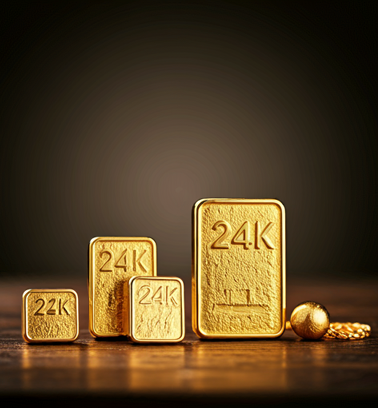When shopping for gold jewelry, you’ve probably noticed the term “karat” thrown around quite a bit. But what exactly does it mean? Karats are a measure of the purity of gold, and understanding this system is key to making informed decisions when purchasing gold items. In this blog, we’ll break down what karats are, how they affect the quality and value of gold, and why they’re important when buying or selling gold jewelry.
What Are Karats?
 The term “karat” refers to the unit of measurement used to express the purity of gold. Gold in its purest form is 24 karats, which means that 24 out of 24 parts of the metal are gold. However, pure gold is often too soft for practical use in jewelry or other items, so it’s mixed with other metals like silver, copper, or nickel to create a stronger alloy.
The term “karat” refers to the unit of measurement used to express the purity of gold. Gold in its purest form is 24 karats, which means that 24 out of 24 parts of the metal are gold. However, pure gold is often too soft for practical use in jewelry or other items, so it’s mixed with other metals like silver, copper, or nickel to create a stronger alloy.
Here’s a simple breakdown of common karat measurements:
- 24K Gold: This is pure gold, or 99.9% gold. It is soft, malleable, and often used for investment purposes or in special items rather than daily-wear jewelry.
- 22K Gold: 22 parts gold and 2 parts other metals, making it 91.67% pure. It’s often used in high-quality, but more durable jewelry.
- 18K Gold: 18 parts gold and 6 parts other metals, making it 75% pure. This is a common choice for fine jewelry, offering a balance between purity and durability.
- 14K Gold: 14 parts gold and 10 parts other metals, or 58.3% gold. It’s durable, affordable, and frequently used in rings, bracelets, and other everyday items.
- 10K Gold: 10 parts gold and 14 parts other metals, making it 41.7% gold. It’s the least pure form of gold that can still legally be called gold in some countries.
Why Do Karats Matter?
 Karats play a significant role in determining both the value and characteristics of gold jewelry. The higher the karat, the more expensive the piece tends to be, since it contains a greater percentage of pure gold. However, lower-karat gold can be more durable and resistant to scratches, making it ideal for pieces you wear daily, like rings or bracelets.
Karats play a significant role in determining both the value and characteristics of gold jewelry. The higher the karat, the more expensive the piece tends to be, since it contains a greater percentage of pure gold. However, lower-karat gold can be more durable and resistant to scratches, making it ideal for pieces you wear daily, like rings or bracelets.
- Durability: As mentioned, pure gold (24K) is very soft and prone to scratches and dents. Mixing it with other metals enhances its strength. This is why 14K or 18K gold is commonly used in jewelry that’s worn regularly.
- Color: The metals mixed with gold also influence its color. For instance, rose gold gets its pinkish hue from copper, while white gold is mixed with palladium or silver for a silvery-white look.
- Price: The price of gold jewelry is heavily influenced by its karat. A 24K gold necklace, for example, will cost significantly more than a 14K one, not just because it’s purer, but because it contains a higher proportion of gold by weight.
Choosing the Right Karat for You
When choosing gold jewelry, consider both aesthetics and practicality. Higher-karat gold (22K and 24K) is ideal if you’re looking for investment pieces or heirloom-quality items that are mostly for show. On the other hand, if you want something sturdy that can withstand everyday wear, 14K or 18K gold might be a better fit.
Another factor to keep in mind is sensitivity. Some people have allergic reactions to metals like nickel, which is often used in lower-karat gold. If you have sensitive skin, you may want to choose jewelry that has a higher gold content or is made with hypoallergenic alloys.
How Karats Affect Resale Value
Gold is a timeless investment, but its resale value depends largely on its purity. Higher-karat gold generally has a higher melt value, meaning it can be sold for a higher price when melted down and reused. However, the market value of gold fluctuates, so if you’re purchasing gold as an investment, it’s essential to stay informed about current gold prices.
Conclusion
Whether you’re buying gold jewelry for yourself or as a gift, understanding karats is crucial for making a smart purchase. The karat system helps you identify the purity, value, and durability of the gold item you’re interested in. If you’re in the market for gold jewelry, be sure to pay attention to the karat to find the perfect balance between beauty, durability, and investment value.
When it comes to buying or selling gold, knowing your karats will help you make the best decision for your needs.
